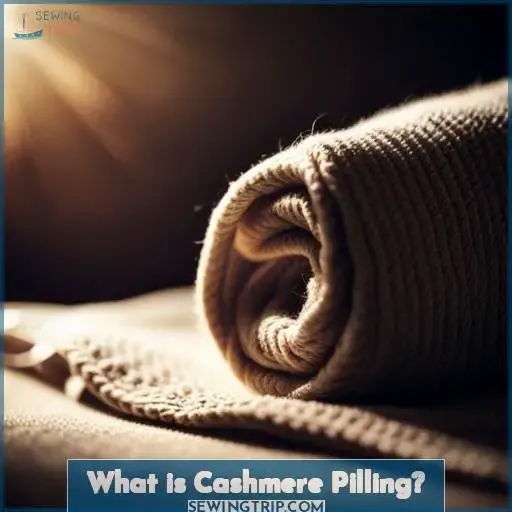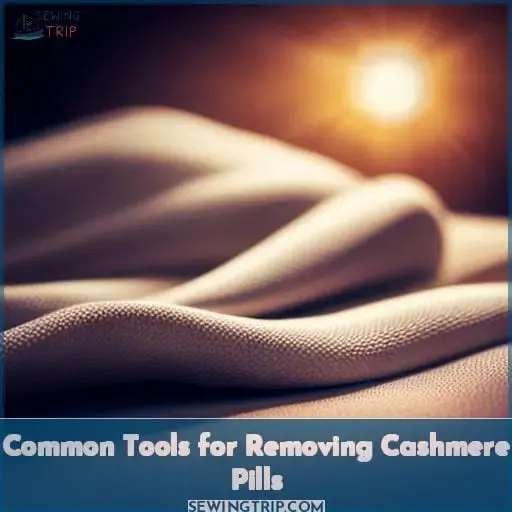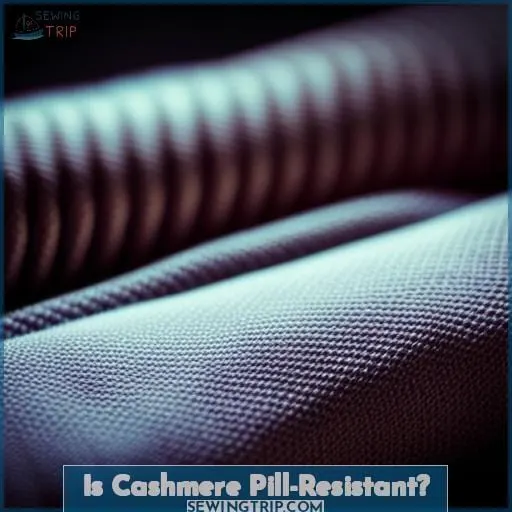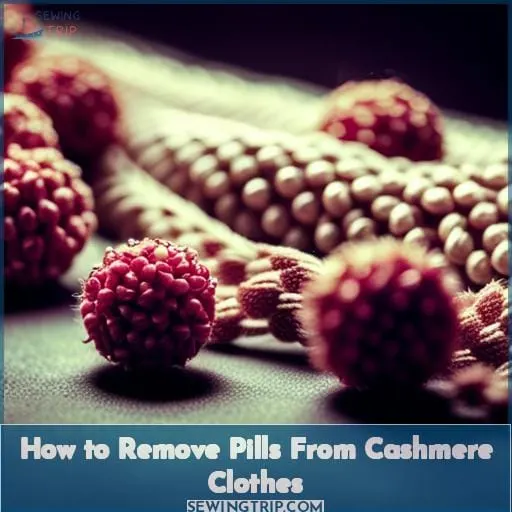This site is supported by our readers. We may earn a commission, at no cost to you, if you purchase through links.
 As soft as a cloud, cashmere is considered the epitome of luxury when it comes to fabrics. But one annoying problem with this exquisite material is pilling – when small balls form on the surface, making your garment look worn out and unattractive.
As soft as a cloud, cashmere is considered the epitome of luxury when it comes to fabrics. But one annoying problem with this exquisite material is pilling – when small balls form on the surface, making your garment look worn out and unattractive.
With proper selection and care though, you can prevent cashmere pilling from happening in the first place. In this article we’ll discuss how to select quality cashmere pieces that are less likely to pill, along with tips for caring for them properly so that they stay looking good longer.
We’ll also go over some tools you can use if pills do appear – plus alternative materials if you’re looking for something more resistant than cashmere!
To start, look for cashmere with a tight weave and no loose threads or slubs. The tighter the weave, the less likely it is that pills will form. Also avoid buying super cheap cashmere, as it tends to be lower quality and pill faster.
When caring for your cashmere, avoid friction that can pull fibers and start pilling. Don’t vigorously rub the item when washing, and store it folded rather than hanging to prevent fibers catching and pulling against other garments.
If pills do occur, remove them promptly with a sweater stone, pill shaver, or depiller – special tools designed to gently remove pills without damaging the cashmere. Just be careful not to over-use them. Also consider protective undergarments that form a barrier between your cashmere and other fabrics.
While not as luxurious, synthetic fibers like polyester and nylon are more durable and pill-resistant alternatives to cashmere. Or try wool, alpaca, or mohair sweaters that still give a soft hand-feel. With some care in selection and laundering, you can keep your cashmere looking pristine.
Table Of Contents
- Key Takeaways
- What is Cashmere Pilling?
- Factors That Contribute to Cashmere Pilling
- How to Prevent Cashmere Pilling
- Common Tools for Removing Cashmere Pills
- Alternatives to Cashmere Clothing
- Is Cashmere Pill-Resistant?
- How to Identify Superior Quality Cashmere
- How to Remove Pills From Cashmere Clothes
- Seeking Professional Help for Cashmere Care
- Conclusion
Key Takeaways
- Cashmere pilling is caused by friction and can be prevented by using high-quality cashmere with a tight weave and no loose threads.
- Avoid super cheap cashmere and take precautions to prevent friction when caring for cashmere to prevent pilling.
- Hand wash or dry clean cashmere with mild detergent, then store it properly in airtight containers with acid-free tissue paper.
- Consider using specialized tools like sweater stones or fabric shavers to gently remove pills. You may also want to consider alternative materials like synthetic fibers or natural fibers that are more pill-resistant than cashmere.
What is Cashmere Pilling?
Cashmere pilling is when your soft cashmere sweater starts to fuzz and bobble from friction against itself or other surfaces. This annoying pilling results from the delicate nature of cashmere fibers breaking down with repeated abrasion.
Choosing high quality cashmere graded A will help resist pilling versus lower grades B or C. Hand washing gently with mild detergent helps preserve the fibers. Also, avoid frequent wear between washes and don’t let cashmere rub against rough surfaces.
When storing, use breathable, acid-free tissue paper between layers. Although pilling is common, proper preventive care will keep your cashmere looking its best. Other natural fabrics like cotton and linen are more durable alternatives if you want to avoid pilling issues altogether.
But with the right quality and care measures, cashmere can maintain its soft luxury for years to come.
Factors That Contribute to Cashmere Pilling
Several factors contribute to cashmere pilling. The quality of the cashmere fibers plays a major role – lower grades like B and C are more prone to pilling from wear and tear. Environmental factors like humidity and friction from surfaces or layers rubbing can also break down fibers over time.
Quality of Cashmere
When purchasing cashmere, aim for the highest grades that can withstand friction and daily wear without those pesky pills. Choosing the finest cashmere you can afford ensures lasting beauty that resists pilling initially.
Look for reputable brands graded A for superior quality with built-in pilling resistance. Selecting top-tier natural fibers prevents pills and preserves your purchase. With proper care and handling, luxury-grade cashmere brings timeless elegance without the fuzz.
Wear and Tear
Caring deeply, restore garments’ glory with thorough yet gentle handling daily. Cashmere’s delicate fibers require a light touch to prevent pilling. Avoid overuse between launderings; turn inside out when washing. Use a garment comb gently after air drying to lift pills for removal.
Store properly; never pile – give cashmere breathing room. With mindful wear and care techniques, preserve your treasured knits.
Environmental Factors
The air in your closet can actually contribute to cashmere pilling. Exposure to excess humidity and heat weakens fibers over time. High temperatures also contribute to friction and can accelerate fabric breakdown.
Use desiccants or cedar blocks. Store in breathable containers. Limit direct sun exposure. Maintain climate control. By regulating the environment, you’ll preserve your investment pieces.
How to Prevent Cashmere Pilling
When investing in cashmere, opt for the highest quality you can afford and properly care for it to prevent pilling. Give your cashmere the attention it deserves by hand-washing with care, avoiding overuse between washes, steering clear of snags, and storing properly in airtight containers.
Doing so will help minimize pesky pilling and prolong its life. To preserve cashmere, handle it gently and fold neatly to avoid pulls. Use a cashmere comb to remove existing pills. Store off season cashmere in breathable garment bags.
High-Quality Cashmere Selection
You’ll treasure that lush cashmere when you invest in the finest grade. Look for premium Mongolian fibers graded A for optimal softness and durability. These luxurious, long staple fibers resist friction and keep delicate fuzz intact.
Though pricey, the unrivaled comfort and longevity reward your choice. Hand-pick each garment and care for it properly.
Proper Care and Maintenance
Stop your chattering and avoid cashmere catastrophes by being proactive with simple precautions. Use a fabric shaver to gently remove pills as they form. Hand wash in mild detergent and lay flat to dry.
Keep cashmere garments separated and stored in breathable spaces. Quality cashmere endures with care, so nurture its longevity. Thoughtful handling preserves the indulgent feel you expect from this exceptional fiber.
Storage Tips
You’d be amazed to learn that properly stored cashmere can last over 50 years. Fold cashmere flat and store in airtight containers to protect from moisture and clothes moths. Use acid-free tissue paper between layers. Inspect regularly for signs of damage and seek professional help for repairing heirlooms.
With proper storage, your investment in quality cashmere will reward you for decades.
Common Tools for Removing Cashmere Pills
Removing cashmere pills can restore the appearance and feel of your garments. Lint rollers, fabric shavers, and sweater stones gently remove fuzzy pills without damaging the delicate cashmere fabric.
Lint Rollers
You can tackle those pesky pills with a trusty lint roller for quick on-the-go care. Lint rollers effectively remove surface pills and fuzz from cashmere. Their adhesive sheets grab onto pills for easy removal.
Rollers come in reusable and disposable types. For best results, roll gently in various directions. Replace sticky sheets often for maximum effectiveness. With regular use, lint rollers keep cashmere looking pristine between deep cleanings.
Fabric Shavers
Gently brush the fabric shaver across your sweater’s surface and watch as those annoying pills vanish right before your eyes. This handy lint remover restores and revives your cashmere and other delicate fabrics with precision and ease.
Safeguard your investment pieces from damage by using this portable, battery-powered tool. Its ergonomic grip and adjustable shaving heads tackle fuzz and pilling without harming the underlying fibers.
Travel-ready and mess-free, the fabric shaver brings new life to tired garments.
Sweater Stones
Using sweater stones gently along the surface makes short work of stubborn pills. Rub the stone gently over pilled cashmere for gentle yet effective pill removal. Sweater stones keep cashmere soft and pristine while preserving its feel and fibers.
Circular motions with a sweater stone uplift cashmere’s delicate texture. Apply light, even pressure and brush across pilled areas. Let these handy tools renew cashmere naturally. Treasure cashmere’s luxury with sweater stones’ mild touch.
Alternatives to Cashmere Clothing
Cashmere pilling is unfortunately common, but you have alternatives. Cotton, linen, and hemp are natural fibers known for resisting pills, whereas synthetics like polyester are quite durable.
Pilling-Resistant Fabrics
Til lately you’d be better off wearing cotton, linen, or hemp than cashmere to dodge those pesky fabric balls. But superior cashmere fabric resists pilling pretty well nowadays. Choosing natural fibers like cotton and linen over synthetics reduces microplastics.
When picking clothes, consider how often you’ll wear and wash the item. More durable fabrics extend a garment’s life. For day-to-day clothes, sustainable fabrics like organic cotton better withstand frequent wear.
But for special occasion pieces, quality cashmere holds up if properly cared for.
Synthetic Fiber Options
You’d love durable polyester or easy-care acrylic for pilling-free pieces. Synthetic fibers resist abrasion, so they stay smooth despite rubbing. Polyester excels at keeping its shape while looking neat and crisp. It lends structure to blends and travels well, since wrinkles shake out easily.
Though polyester withstands wear, allow breathing room when possible. Acrylic offers stretch while mimicking luxurious cashmere minus the high maintenance. Sweaters knit with acrylic maintain their loft and remain pilling-free. You’ll get longevity from synthetics with fewer pills.
Is Cashmere Pill-Resistant?
Though spending top dollar may seem appealing, what’s done is done if your next brush finds bobbles abound. Unfortunately, cashmere isn’t naturally pill-resistant. The delicate fibers tend to break down with friction against surfaces, clothing, and jewelry.
- Invest in quality cashmere with long, strong fibers.
- Hand wash gently and lay flat to dry.
- Use a de-pilling comb or shaver.
- Allow cashmere breaks between wears.
- Turn garments inside-out when washing.
While cashmere requires diligent care, its unparalleled softness makes the effort worthwhile. With preventative maintenance and early treatment of pills, your coveted cashmere can maintain its integrity for seasons to come.
Knowledge is power – arm yourself with smart practices to cherish that buttery cashmere feeling as long as possible.
How to Identify Superior Quality Cashmere
You’ll know high-end cashmere by its silky soft touch and natural fibers without synthetic blends that compromise longevity.
Here are 4 ways to identify superior quality cashmere:
- Check the Origin – Mongolian and Scottish cashmere is prized for its exceptional softness and durability.
- Inspect the Fibers – Quality cashmere has long, smooth fibers without breaks or irregularities.
- Feel the Fabric – It should feel feather-light and incredibly soft without any coarseness.
- See How it Drapes – Finer cashmere drapes smoothly without resistance.
The most luxurious cashmere is made from pure natural fibers without synthetic blends. It has an impeccable handfeel and drape. When identifying quality, trust your senses – only the most exceptional cashmere passes the touch and feel test.
How to Remove Pills From Cashmere Clothes
Once you notice those pesky pills forming on your favorite cashmere sweater, attack them swiftly with a fabric shaver before they multiply like rabbits. Your treasured garment can quickly become an eyesore if you let the pills go unchecked.
- Invest in a fabric shaver or lint brush. These handy tools gently shave or remove pills without damaging the cashmere.
- Work in sections, holding the cashmere taut. Make straight, even strokes and avoid going over the same area repeatedly.
- Check the lint compartment frequently to avoid clogs. Empty it after each use.
- For stubborn pills, try steaming the area first to loosen fibers. Let it cool before shaving.
- Finish by hanging or laying flat to restore the cashmere’s smooth texture. Periodic reshaving maintains its pristine condition.
With some patience and the right tools, those pesky pills don’t stand a chance. Keeping cashmere blemish-free ensures it stays ultrasoft and pill-free for seasons.
Seeking Professional Help for Cashmere Care
As heirlooms require expert handling, trust professionals when treasured cashmere needs special care. While regular pilling and wear often just requires diligent at-home care, heirloom or vintage garments deserve special attention.
Seek out reputable cleaners in your area that specialize in delicate fabrics like cashmere.
| Service | Description | Cost |
|---|---|---|
| Full Restoration | Repair worn areas, reshape, fully restore | $$$ |
| Tailoring | Adjust fit, repair discreetly | $$ |
| Deep Cleaning | Deep clean in unsafe ways at home | $$ |
Let the experts handle garments passed down or purchased for keepsakes. With artful hands and specialized tools, professionals can maintain or fully restore cherished cashmere. From a simple press to intricate mending, trust them to keep your heirlooms timeless.
Conclusion
The soft and luxurious texture of cashmere makes it a popular choice of fabric for clothing. However, cashmere is prone to pilling, which can detract from its beauty and longevity. To prevent cashmere pilling, it is important to select high-quality cashmere, follow proper care and maintenance instructions, and store it properly.
Additionally, lint rollers, fabric shavers, and sweater stones can help remove pills. If cashmere is not an option, pilling-resistant fabrics and synthetic fibers can serve as alternatives.















